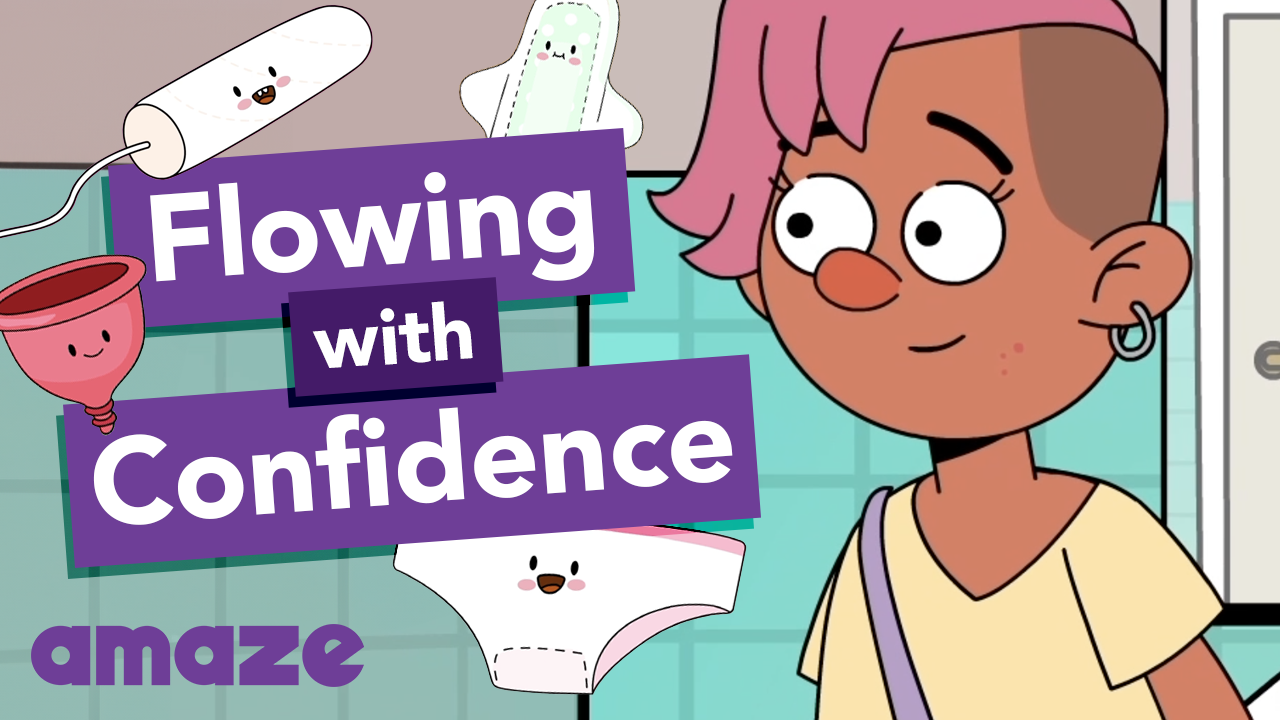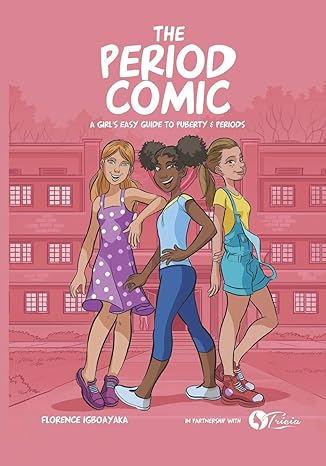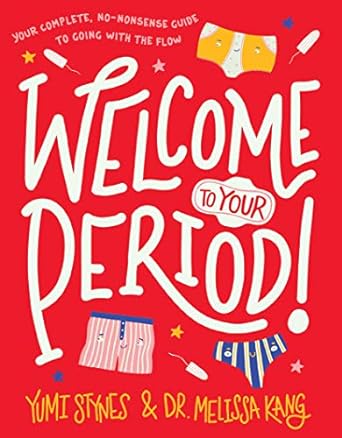Flowing with Confidence
During your menstrual cycle, you may experience a wide range of emotions and feelings and use various menstrual hygiene products. [AMZ-160]
Flowing with Confidence
Most young people with a vulva will experience a menstrual cycle also known as a period. Every young person should feel confident when having their cycle.
Menstrual Hygiene Products
Exploring a variety of menstrual products:
- It’s important to learn about each type of menstrual product.
- You have the right to choose the best menstrual product for you! And you change the product you choose at anytime.
- Each menstrual product requires a different level of care.
Youth
Okay, so you know how our bodies go through changes as we grow up? Well, for people with uteruses, one of those changes is something called the menstrual cycle. This is a totally natural process where the lining of the uterus (kind of like a cozy blanket inside) sheds, and that’s what causes the bleeding we call a period. Usually, this lasts for about 5-7 days.
Now, when you’re on your period, it might feel a little uncomfortable, but there are things called menstrual hygiene products that can help make it easier. These are things like pads, tampons, menstrual cups, and special underwear made for periods. They soak up the blood and keep you feeling dry and comfy. Plus, they stop any leaks or stains on your clothes, which is super helpful!
Sometimes people think that when you have your period, you have to stay home and can’t do fun stuff like hang out with friends or play sports. But with these hygiene products, you can still do all those things! They help you stay active and do the things you love without any worries. So, having a period doesn’t have to stop you from enjoying life.
It’s essential to use clean and comfortable menstrual products like pads, tampons, period underwear, or menstrual cups to prevent infections. Depending on the product you choose (and it’s completely up to you), remember to change them regularly. Pads and reusable pads should be changed every 3-4 hours, tampons every 4-8 hours, menstrual cups emptied, cleaned, and reinserted every 10-12 hours, and period underwear changed every 4-6 hours. Reusable options like pads and underwear can be washed and reused for up to a year, while menstrual cups can be used for 5-10 years.
Unfortunately, some people who have periods don’t have access to affordable menstrual products. If you find yourself in this situation, don’t worry! You can create makeshift pads using household items. For example, folding several sheets of toilet paper or paper towel and securing them in your underwear works in a pinch. You can also make reusable pads by sewing together fabrics like cotton and fleece.
Taking care of your menstrual hygiene is crucial for your overall health and happiness. By staying informed and practicing proper hygiene, you can confidently navigate your menstrual cycle and embrace every part of your journey!
FAQs
There are no set changes that happen for everyone. Some girls begin with growth spurts during which they grow taller. For others, the first sign may be that their breasts begin to grow or hair starts to grow under their arms and in their pubic area.
During puberty, girls begin to get their menstrual periods. Menstrual periods are when a small amount of blood and tissue leave the body through the vagina over the course of a few days. It happens about once every month and can last from a couple of days to a week. Some girls have cramps during their periods while others don’t. Girls commonly use a maxi pad, tampon or feminine hygiene cup to manage the blood that leaves their body during a period.
When a girl gets her first period, it signals that her body has begun ovulating. Ovulation happens once a month when a hormone or chemical in the body signals a girl’s ovaries to release an egg or ovum. This means that if a girl has unprotected sex she could become pregnant. The hormone estrogen is also released to signal to the girl’s uterus to build up its lining. If after sex an egg is fertilized by a sperm, the fertilized egg will implant in the lining and cause a pregnancy. If an egg is not fertilized within 12 to 24 hours after ovulation, the egg dies and disintegrates. Two weeks later, when the uterus realizes there is no fertilized egg, the built-up lining of the uterus is released, or shed, during a girl’s menstrual period.
Boys often begin puberty a little later than girls. Below are some common changes boys go through during puberty:
- Growing hair on the face, under the arms and in the genital area
- Growing taller
- Broadening shoulders
- Deepening voice
- Having frequent and at times spontaneous erections
Possibly experiencing wet dreams, meaning ejaculating semen while sleeping. (This is normal if it happens and normal if it does not.)
Test your knowledge
Parents
Understanding menstrual health is essential for your child’s overall well-being, including their emotional, mental, and social health. As your child grows, they may experience a menstrual cycle, a natural process where the lining of the uterus sheds, leading to bleeding that typically lasts for 5-7 days.
During menstruation, your child may use various menstrual hygiene products such as pads, tampons, menstrual cups, reusable pads, or period underwear. These products absorb or catch menstrual blood, keeping your child feeling dry and comfortable throughout the day. They also help prevent leaks or stains on their clothes, enabling your child to continue participating in school, sports, and social activities.
It’s important for your child to use clean and comfortable menstrual products to prevent bacterial infections. Depending on the menstrual product they choose, which is entirely up to them, these products should be changed regularly. Pads and reusable pads should be cleaned or changed every 3-4 hours, tampons every 4-8 hours, menstrual cups emptied, cleaned, and reinserted every 10-12 hours, and period underwear changed every 4-6 hours. Reusable options like pads and underwear can be used, washed, and dried for up to a year, while menstrual cups can be used for 5-10 years.
Unfortunately, some people who menstruate do not have access to affordable menstrual products. If your child finds themselves in this situation, they can use household items to create makeshift menstrual products. For example, folding several sheets of toilet paper or paper towels and securing them in their underwear works in emergencies. They can also make reusable pads using fabrics like cotton and fleece.
Encouraging your child to take good care of their menstrual hygiene is crucial for their overall health and happiness. By providing them with information and support and encouraging proper hygiene practices, you can help them confidently navigate their menstrual cycle and embrace every aspect of their journey
Below are some ways to start these conversations:
When she mentions a friend you know, you can say, “Wow, Amber has really developed this year.” You can then use this time to talk about how different people go through puberty at different ages.
When you get home and unpack the groceries, tell your daughter that you bought these for her. Explain that you know that she hasn’t gotten her period yet and that it may still be awhile, but you want her to know that these things are here for her when she needs them. You can go on to talk more about how to use them and/or tell her you are always there for her, whenever she wants to talk more about these things.
Educators
Understanding menstrual health is crucial for students’ overall well-being, including their emotional, mental, and social health. Some students may experience a menstrual cycle, a natural process where the lining of the uterus sheds, leading to bleeding that typically lasts for 5-7 days.
During menstruation, students might use pads, tampons, menstrual cups, reusable pads, or period underwear. These are called menstrual hygiene products, and they absorb or catch menstrual blood, keeping students feeling dry and comfortable throughout the day. They also help prevent leaks or stains on students’ clothes, allowing them to participate fully in school, sports, and social activities.
It’s important for students to use clean and comfortable menstrual products to prevent bacterial infections. Depending on the menstrual product they choose, which is entirely up to them, these products should be changed regularly. Pads and reusable pads should be cleaned or changed every 3-4 hours, tampons every 4-8 hours, menstrual cups emptied, cleaned, and reinserted every 10-12 hours, and period underwear changed every 4-6 hours. Reusable options like pads and underwear can be used, washed, and dried for up to a year, while menstrual cups can be used for 5-10 years.
Unfortunately, some students who menstruate do not have access to affordable menstrual products. If students find themselves in this situation, they can use household items to create makeshift menstrual products. For example, folding several sheets of toilet paper or paper towels and securing them in their underwear works in emergencies. They can also make reusable pads using fabrics like cotton and fleece.
Encouraging students to take good care of their menstrual hygiene is crucial for their overall health and happiness. By providing them with information and support and encouraging proper hygiene practices, teachers can help students confidently navigate their menstrual cycle and embrace every aspect of their journey!
National Sex Ed Standards
Make a plan for maintaining personal hygiene during puberty
International Technical Guidance on Sexuality Education
Discussion Questions
- How long does a menstrual cycle last?
- What type of menstrual products are available for young people?
- What are some other ways that young people can access menstrual products if they do not have them?
- Why might some young become anxious about having a menstrual cycle?
- Who are some trusted adults you can talk to if you have questions or concerns about a menstrual cycle?



